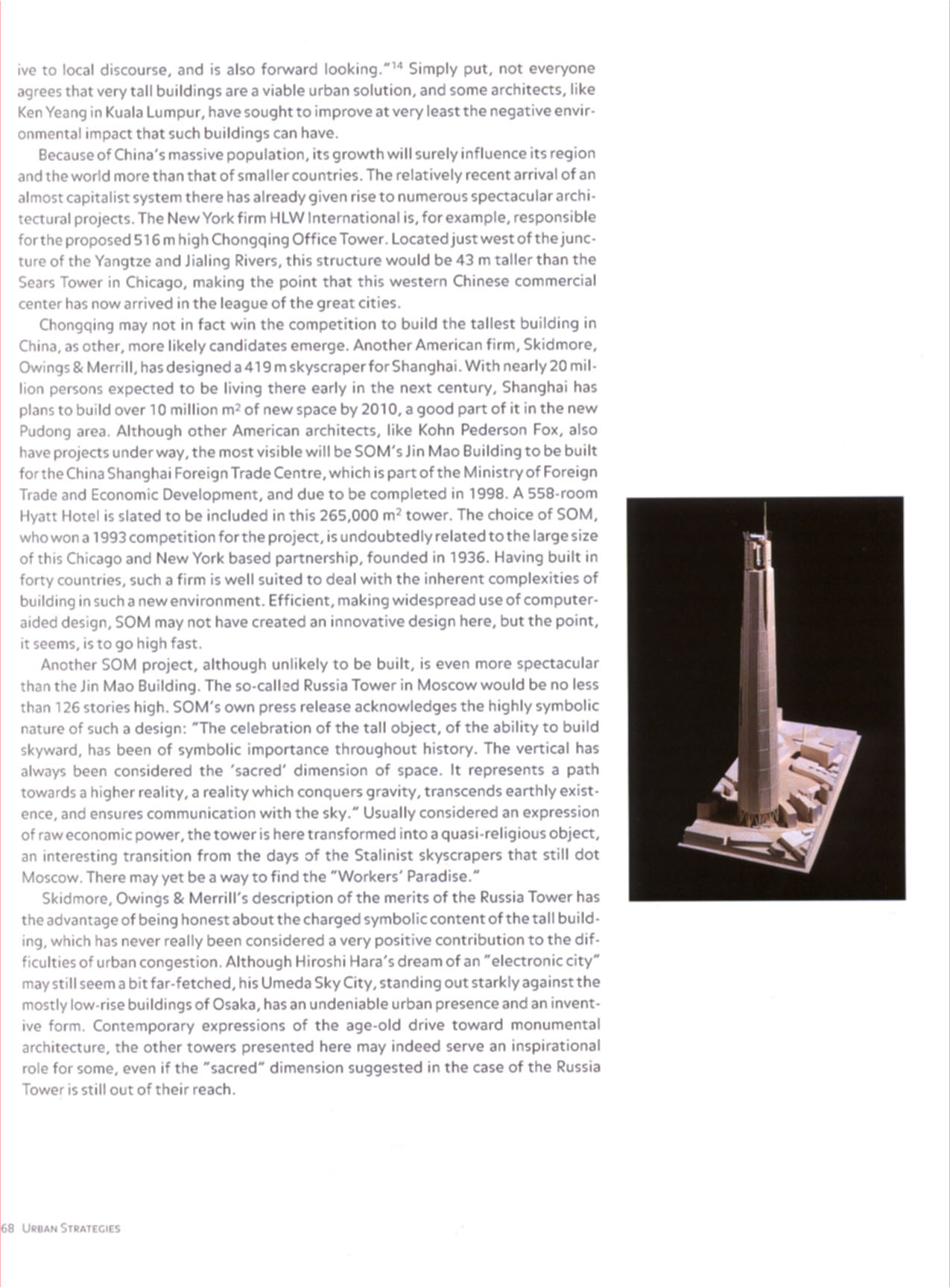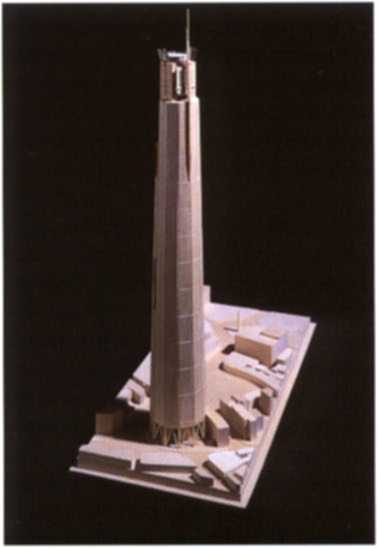New Forms Taschen 063

ive to local discourse, and is also forward looking."14 Simply put, not everyone agrees that very tali buildings are a viable urban solution, and some architects, like Ken Yeang in Kuala Lumpur, have sought to improve at very least the negative envir-onmental impact that such buildings can have.
Becauseof China's massive population, its growth will surely influence its region and the world morę than that of smaller countries. The relatively recent arrival of an almost capitalist system there has already given rise to numerous spectacular archi-tectural projects. The New York firm HLW International is, for example, responsible for the proposed 516 m high Chongqing Office Tower. Located just west of the junc-ture of the Yangtze and Jialing Rivers, this structure would be 43 m taller than the Sears Tower in Chicago, making the point that this western Chinese commercial center has now arrived in the league of the great cities.
Chongqing may not in fact win the competition to build the tallest building in China, as other, morę likely candidates emerge. Another American firm, Skidmore, Owmgs & Merrill, hasdesigned a419 mskyscraperforShanghai. With nearly 20 mil-lion persons expected to be living there early in the next century, Shanghai has plans to build over 10 million m? of newspace by 2010, a good part of it in the new Pudong area. Although other American architects, like Kohn Pederson Fox, also have projects under way, the most visible will be SOM's Jin Mao Building to be built for the China Shanghai Foreign Trade Centre, which is part of the Ministry of Foreign Trade and Economic Development, and due to be completed in 1998. A 558-room Hyatt Hotel is slated to be included in this 265,000 m? tower. The choice of SOM, who won a 1993 competition for the project, is undoubtedly related to the large size of this Chicago and New York based partnership, founded in 1936. Having built in forty countries, such a firm is well suited to deal with the inherent complexities of building in such a new environment. Efficient, making widespread use of Computer-aided design, SOM may not have created an innovative design here, but the point, it seems, is to go high fast.
Another SOM project, although unlikely to be built, is even morę spectacular than the Jin Mao Building. The so-called Russia Tower in Moscow would be no less than 126 stories high. SOM's own press release acknowledges the highly symbolic naturę of such a design: "The celebration of the tali object, of the ability to build skyward, has been of symbolic importance throughout history. The vertical has always been considered the 'sacred' dimension of space. It represents a path towards a higher reality, a reality which conquers gravity, transcends earthly exist-ence, and ensures communication with the sky." Usually considered an expression of raw economic power, the tower is here transformed into a quasi-religious object, an interesting transition from the days of the Stalinist skyscrapers that still dot Moscow. There may yet be a way to find the "Workers' Paradise."
Skidmore, Owings & MerrilFs description of the merits of the Russia Tower has the advantage of being honest about the charged symbolic content of the tali building, which has never really been considered a very positive contribution to the dif-ficulties of urban congestion. Although Hiroshi Hara's dream of an "electronic city" may still seem a bit far-fetched, his Umeda Sky City, standing out starkly against the mostly low-rise buildings of Osaka, has an undeniable urban presence and an invent-ive form. Contemporary expressions of the age-old drive toward monumental architecture, the other towers presented here may indeed serve an inspirational role for some, even if the "sacred" dimension suggested in the case of the Russia Tower is still out of their reach.
fi8 urban Stpatccies

Wyszukiwarka
Podobne podstrony:
New Forms Taschen 183 UH Steven Holi D.E. Shaw and Company Office New York. New York. 1991-92 The re
71714 New Forms Taschen 159 Right Frank Stella "Watson and the Shark” Aluminum on iron base Ove
New Forms Taschen 034 computer-oriented than Eisenman and some others, Erie Owen Moss has nonethe-le
50770 New Forms Taschen 154 the lines between art and architecture, Richard Meier replies, "No.
New Forms Taschen 087 Tadao Ando Naoshima Museum and Mot«l Naoshima. Kagawa, Japan. Phasel, 1990-92
New Forms Taschen 005 IntroductionNew GeometriesSetting the Scene: From Post-Modernism to Deconstruc
New Forms Taschen 022 Pages24/25 Alessandro Mendini ef a/. Groninger Museum Groningen, The Neth
New Forms Taschen 053 that his blighted northern city was included at the last moment in the route t
więcej podobnych podstron